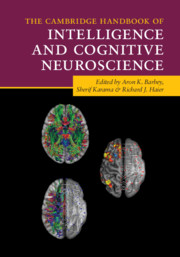Book contents
- The Cambridge Handbook of Intelligence and Cognitive Neuroscience
- Reviews
- The Cambridge Handbook of Intelligence and Cognitive Neuroscience
- Copyright page
- Dedication
- Contents
- Figures
- Tables
- Contributors
- Preface
- Part I Fundamental Issues
- 1 Defining and Measuring Intelligence
- 2 Network Neuroscience Methods for Studying Intelligence
- 3 Imaging the Intelligence of Humans
- 4 Research Consortia and Large-Scale Data Repositories for Studying Intelligence
- Part II Theories, Models, and Hypotheses
- Part III Neuroimaging Methods and Findings
- Part IV Predictive Modeling Approaches
- Part V Translating Research on the Neuroscience of Intelligence into Action
- Index
- References
4 - Research Consortia and Large-Scale Data Repositories for Studying Intelligence
from Part I - Fundamental Issues
Published online by Cambridge University Press: 11 June 2021
- The Cambridge Handbook of Intelligence and Cognitive Neuroscience
- Reviews
- The Cambridge Handbook of Intelligence and Cognitive Neuroscience
- Copyright page
- Dedication
- Contents
- Figures
- Tables
- Contributors
- Preface
- Part I Fundamental Issues
- 1 Defining and Measuring Intelligence
- 2 Network Neuroscience Methods for Studying Intelligence
- 3 Imaging the Intelligence of Humans
- 4 Research Consortia and Large-Scale Data Repositories for Studying Intelligence
- Part II Theories, Models, and Hypotheses
- Part III Neuroimaging Methods and Findings
- Part IV Predictive Modeling Approaches
- Part V Translating Research on the Neuroscience of Intelligence into Action
- Index
- References
Summary
The first neuroimaging studies of intelligence were done with positron emission tomography (PET) (Haier et al., 1988). PET was expensive and invasive but more researchers had access to neuroimaging when Magnetic Resonance Imaging (MRI) became widely available around the year 2000. The advent of advanced MRI methods enabled researchers to investigate localized (region-level) associations of brain measures and measures of intelligence in healthy individuals (Gray & Thompson, 2004; Luders, Narr, Thompson, & Toga, 2009). At the whole-brain level, MRI-based studies have reported a positive association (r = .40 to .51) between some measures of intelligence and brain size (Andreasen et al., 1993; McDaniel, 2005). Several studies at the voxel and regional levels have also demonstrated a positive correlation of morphometry with intelligence in brain regions that are especially relevant to higher cognitive functions including frontal, temporal, parietal, hippocampus, and cerebellum (Andreasen et al., 1993; Burgaleta, Johnson, Waber, Colom, & Karama, 2014; Colom et al., 2009; Karama et al., 2011; Narr et al., 2007; Shaw et al., 2006). More recently, neuroimaging studies have revealed large-scale structural and functional brain networks as potential neural substrates of intelligence (see review by Jung & Haier, 2007 and Barbey et al., 2012; Barbey, Colom, Paul, & Grafman, 2014; Colom, Karama, Jung, & Haier, 2010; Khundrakpam et al., 2017; Li et al., 2009; Sripada, Angstadt, Rutherford, & Taxali, 2019).
- Type
- Chapter
- Information
- Publisher: Cambridge University PressPrint publication year: 2021

